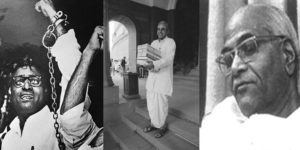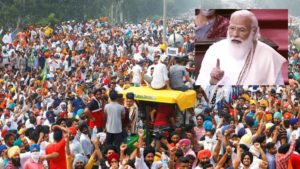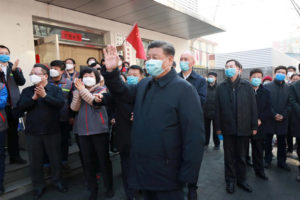Long after India attained freedom, Justice P.B. Chakraborty, in a letter addressed to the publisher of Ramesh Chandra Majumdar’s book A History of Bengal wrote: “… In the preface of the book Dr. Majumdar has written that he could not accept the thesis that Indian independence was brought about solely or predominantly by the non-violent civil disobedience movement of Gandhi. When I was the acting Governor (in 1956), ex-Prime Minister of Britain, Clement Atlee, who had given us independence by withdrawing the British rule from India, spent two days in the Governor’s palace at Calcutta. At that time I had a prolonged discussion with him regarding the real factors that had led the British to quit India. My direct question to him was that since Gandhi’s ‘Quit India’ movement had tapered off quite some time ago and in 1947 no such new compelling situation had arisen that would necessitate a hasty British departure, why did they have to leave? In his reply Atlee cited several reasons, the principal among them being the erosion of loyalty to the British Crown among the Indian army and navy personnel as a result of the military activities of Netaji [Subhash Chandra Bose]. Toward the end of our discussion I asked Atlee what was the extent of Gandhi’s influence upon the British decision to quit India. Hearing this question, Atlee’s lips became twisted in a sarcastic smile as he slowly chewed out the word, “m-i-n-i-m-a-l!”
Many myths have been propagated by the Congress Party’s court historians to make Gandhi as the sole conscience keeper of the nation, and the greatest one is that India attained its independence as a result of Gandhi’s non-violence movement. The official written Indian history which is being taught in schools and colleges is full of such inaccuracies. The truth lies somewhere else.
In fact, two external factors created the circumstances and another internal factor gave it the needed momentum. The external factors were Hitler and the World War II, which together destroyed the economies of Britain and France to such an extent that they were incapable of containing the burgeoning freedom movements in their colonies. Indian historians have forgotten to mention that after WWII, Britain left not only India but nearly all its other holdings, including Jordan in 1946, Palestine in 1947, Sri Lanka in 1948, Myanmar in 1948, Egypt in 1952 and Malaysia in 1957. Even France had to grant independence to Laos in 1949 and Cambodia in 1953, and had to leave Vietnam in 1954. Remember, there were no violent movement and no Gandhi leading a peaceful resistance either.
So Hitler, who no doubt committed crimes against humanity, was instrumental in creating the circumstances for the colonies to achieve independence including India. Right from August 1942 Britain was facing problems at all fronts – the Axis Powers, German Air Force, which was relentlessly bombing on London, and closer home the Japanese were close to India’s borders. But the momentum was provided by the heat generated in the four days (February 18 – February 22, 1946), when the revolt of the naval ratings at Bombay and later on in other ports, not only rocked the port cities and naval establishments of Bombay and Karachi, but also shook the very foundations of the British Empire. It was called a mutiny by the British rulers.
The 250 years old empire was crumbling. After a failed ‘Quit India Movement’ followed by the Delhi Chalo campaign of the INA under the command of Subhash Chandra Bose, the aborted revolt of the naval ratings was indeed a turning point. Here was a signal, loud and clear that the alien rulers could no longer depend or rely upon the ‘loyalty’ of their Indian armed forces. The time had come for them to pack up and quit.
Sailors’ revolt was conducted in the spirit of a true Satyagrah, and was called off when so ordered by the political leaders that be, for whatever their fears and political considerations. It was not just a fight for bread, pulse and some service demands as Nehruvian era’s well-placed historians have propagated extensively. These prejudiced Darbari writers have also left behind controversial, impugned and polemic records to put the serious historians and research scholars in a dilemma.
And ‘chickenhearted’ Congress leaders
Ratings had jointly prepared and placed a Charter of Demands which included political and service demands. RIN ratings, mostly teenagers, received full support and co-operation from the masses in general, although not from the national leaders. Well disciplined, fearless and courageous Indian sailors transformed RIN to be known as INN or Indian National Navy. They replaced Union Jacks and British Flags by Tri-colours and hoisted on the Mast of each and every warship and all naval shore establishments now under their command.
RIN ratings action plan commenced with Hunger Strike on Gandhian line, and ended with the so called Gandhites betrayal. Moulana Abul Kalam Azad, then President of Congress, declined his support and it was Patel, the much celebrated (by the present government) Iron man, who advised Ratings to surrender. Azad in his book India Wins Freedom writes “… Earlier some officers of the Indian Navy had met me in Karachi. Among other things they had complained about racial discrimination…..One day I suddenly read in the newspapers that they had resorted to direct action…..It was clear to me that this was not an appropriate time. I, therefore, felt that this move on the part of the officers of the Indian Navy was wrong….Aruna Asaf Ali came to Delhi to win my support. I told her that the officers had not acted wisely and my advice to them was that they must go back to work unconditionally.”
Not only that, the Congress President sought an interview with the Commander-in Chief, Lord Auchinleck, and put forward his viewpoint that: The Congress had not approved of the action of the naval officers and has advised them to go back to work unconditionally. Congress is, however, anxious that there should be no victimization. And, the racial discrimination and other grievances of the naval officers must be examined and removed. Lord Auchinleck assured Maulana Azad, who issued a statement calling upon the rebels to return to duty.
Verdict of History
The troubles in the Navy began on 18 February, 1946. On the very next day, 19 February, 1946, Lord Pethick-Lawrence in the House of Lords and Prime Minister Attlee in the House of Commons made a simultaneous announcement that in view of the paramount importance, His Majesty’s Government had decided to send out to India a special mission consisting of three Cabinet Ministers (Cripps Commission). Thus the decision of dispatching a Cabinet Mission was hastened by the revolt of the naval ratings. It was felt that the grant of independence to India was now a certainty. Prime Minister Attlee in the House of Commons on 15 March, 1946, said “that the tide of nationalism was running very fast in India and that it was time for clear and definite action.” The temperature of 1946 was not the temperature of 1920, 1930, or even 1942.
The Cabinet Mission arrived in New Delhi on 24 March, 1946. But soon the initiative was lost. The unity of purpose as reflected in the INA struggle and the Naval Uprising was lost in the game of prolonged negotiations and bargaining sessions in New Delhi and in Shimla. There were claims and counterclaims and the political stands of different parties hardened. As a result the Mission packed up and went home. Another year passed one of street battles and direct actions, of riots and what not, before suddenly out of the blue, came the Mountbatten Plan to divide and quit.
Pakistan’s record is far better
India was partitioned and the new rulers too termed the uprising ‘Rin Mutiny’ and administrative machinery remained unchanged. As mentioned above, Congress leaders had assured the Ratings that they will fight against large-scale victimization. But when they really got the power they did not allow any mutineers to rejoin the Indian Navy after independence. As a result, many sailors and mass supporters fell victims to such an arbitrary policy that some died of hunger and malnourishment. On the other side of the border, Pakistan Navy absorbed all those who wanted to join it, including MS Khan, President of the Naval Central Strike Committee.
Gandhi’s dilemma
For Congress and particularly Gandhi, Azad Hind Fauz, and such other elements including Netaji were an irritant. Nehru had openly denounced the INA “as a puppet force of the Japanese fascists and had vowed to fight it himself if Bose’s army succeeded in marching into India.” It was the public mood that led him to change his stance.
In fact Gandhi had no concrete idea of how to bring about India’s independence. When at the Madras Congress session in 1927, a resolution was passed declaring India’s complete independence, Gandhi was annoyed. So in the following year at the Calcutta Congress Session in 1928 the previous resolution was modified to request dominion status under the British. In his book The Indian Struggle, Bose (Netaji) described his first meeting with Gandhi in 1921: “I began to heap question upon question…The reply to the first question satisfied me…His reply to the second question was disappointing and his reply to the third question was no better…My reason told me clearly…that there was a deplorable lack of clarity in the plan which the Mahatma had formulated and that he himself had no clear idea of the successive stages of the campaign which would bring India to her cherished goal of freedom.”
However, Gandhi was lucky with circumstances and aided by similar ambitious followers otherwise his movement would have slowly fizzled out and he would have gone down in history as simply one of several great Indian freedom fighters of the times.
Role of Muslims
MM Khurana, a member of the INA army writes: “It may sound strange but all the senior commanders except one who was a Sikh, who led us through the flee-infested jungles of Indo-Burma border, to invade the allied armies, were Moslems, mostly from the North West of India. They were prepared to make all possible sacrifices at the behest of Netaji for our country’s independence. Not only the commanders, but Netaji’s right hand men, were two Moslem officers. One from Hyderabad, Abid Hasan Safrani who coined our salutation Jai Hind and the second was Colonel Habibur-Rehman.”
Khurana further writes that “to be meek and cowardly were human qualities unknown to Netaji. Perhaps this bold and robust approach that Netaji manifested on all occasions, endeared him to the Moslem officers and attracted their loyalty….He inspired us all, but his bold approach attracted the Moslems more.” Most of Bose’s army cadres were Muslims.
And not to forget the Gaddars
Britain was able to suppress the First War of Independence of 1857 mainly because of the support of the Sikhs and Pathans. The Sikh princes and Pathans of the Punjab and North-West Frontier Province helped the British in the recapture of Delhi by providing soldiers. Also the large princely states of Hyderabad, Mysore, Travancore, and Kashmir, as well as the smaller ones of Rajputana, did not join the rebellion. Had they not supported the British at that time, Britain would have had to leave India in 1857.
It is certainly a matter of national shame that neither the role played by Rash Behari Bose, Capt Mohan Singh, Netaji, INA and the group that shook the very foundation of British empire in Bombay towards achieving the goal of India’s independence is given due recognition.
I’m ready to put a bet that most of the present ‘top leaders’ including those who are heading political parties (most of them in fact not more than family-run enterprises) even know the history of India’s struggle for freedom.
























